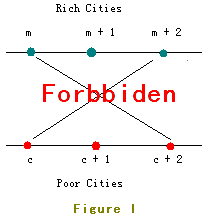题目地址:http://acm.hdu.edu.cn/showproblem.php?pid=1025
Constructing Roads In JGShining's Kingdom
Time Limit: 2000/1000 MS (Java/Others) Memory Limit: 65536/32768 K (Java/Others)Total Submission(s): 8648 Accepted Submission(s): 2468
Half of these cities are rich in resource (we call them rich cities) while the others are short of resource (we call them poor cities). Each poor city is short of exactly one kind of resource and also each rich city is rich in exactly one kind of resource. You may assume no two poor cities are short of one same kind of resource and no two rich cities are rich in one same kind of resource.
With the development of industry, poor cities wanna import resource from rich ones. The roads existed are so small that they're unable to ensure the heavy trucks, so new roads should be built. The poor cities strongly BS each other, so are the rich ones. Poor cities don't wanna build a road with other poor ones, and rich ones also can't abide sharing an end of road with other rich ones. Because of economic benefit, any rich city will be willing to export resource to any poor one.
Rich citis marked from 1 to n are located in Line I and poor ones marked from 1 to n are located in Line II.
The location of Rich City 1 is on the left of all other cities, Rich City 2 is on the left of all other cities excluding Rich City 1, Rich City 3 is on the right of Rich City 1 and Rich City 2 but on the left of all other cities ... And so as the poor ones.
But as you know, two crossed roads may cause a lot of traffic accident so JGShining has established a law to forbid constructing crossed roads.
For example, the roads in Figure I are forbidden.

In order to build as many roads as possible, the young and handsome king of the kingdom - JGShining needs your help, please help him. ^_^
You should tell JGShining what's the maximal number of road(s) can be built.
2 1 2 2 1 3 1 2 2 3 3 1
Case 1: My king, at most 1 road can be built. Case 2: My king, at most 2 roads can be built.HintHuge input, scanf is recommended.
首先是要理解题意。题目说的是一个国王在一条河的两岸各有相等数量的村庄,一边是富有资源的,一边是缺少资源的,而且每个村庄和另外一个村庄正好互补,都是一一互补的。现在要在一一对应的村庄之间开通船的航线,但是航线不能交叉,问你最多能修多少条河。设一边的为a1,a2,a3,a4,a5,他们是有序的,他们分别和b1,b2,b3,b4,b5之间可以开通航线,例如,因为a1<a2,但是b1>b2,那么他们之间的航线就交叉了。所以不行。假设在a这边开通的一次是a1,a2,a3,a4,那么在河对岸和他们相连的b1,b2,b3,b4肯定也是单调递增的,因为a1<a2<a3<a4,若中间出现bi>bj的情况(i<j),就会出现交叉的情况,所以解题思路也就出来了。先对一边的进行排序。使得a1<a2<a3<...<ai<...<an,而对对面的b求出最长递增子序列的长度,就是最多能开通的航线数了。
但是这还远远不够。因为你会看到题目给的数据十分的大,有500000之多,所以用常规的O(n^2)算法果断超时。那么我们就要将这种算法,是时间复杂度降一降。
--------------------------------------------------------------------------------------------------------------------------------------------------------------------------------------
用二分查找优化的最长单调子序列的算法,时间复杂度为O(n*logn)
#include<iostream>
#include<algorithm>
using namespace std;
/* 用的O(n^2)的算法会超时
struct citys
{
int first,second;
};
#define MAX 500500
citys mycity[MAX];
int f[MAX];
bool cmp(citys a, citys b)
{
return a.first<b.first;
}
int main()
{
int n;
int count = 1;
while(cin>>n && n)
{
int i,j;
f[0] = 0;
for(i=1;i<=n;i++)
{
scanf("%d%d",&mycity[i].first,&mycity[i].second);
f[i] = 0;
}
sort(mycity+1,mycity+1+n,cmp);
//开始求最大递增子序列
int ans = 0;
mycity[0].second = -1;
for(i=1;i<=n;i++)
{
for(j=i-1;j>=0;j--)
{
if(mycity[j].second < mycity[i].second && f[j]+1 > f[i])
f[i] = f[j]+1;
}
if(ans < f[i])
ans = f[i];
}
printf("Case %d:\n",count++);
if(ans == 1 )
printf("My king, at most %d road can be built.\n\n",ans);
else
printf("My king, at most %d roads can be built.\n\n",ans);
}
return 0;
}
*/
struct citys
{
int f,s;
};
#define MAX 500050
citys a[MAX];
int dp[MAX];
bool cmp(citys a, citys b)
{
return a.f<b.f;
}
int solve(int n)
{
int i;
sort(a+1,a+1+n,cmp);
dp[1] = a[1].s;
int len;
int low,high,mid;
len = 1;
for(i=2;i<=n;i++)
{
low = 1;
high = len;
while(low <= high)
{
mid = (low + high)/2;
if(a[i].s>dp[mid])
low = mid+1;
else
high = mid-1;
}
dp[low] = a[i].s;
if(low > len)
len = low;
}
return len;
}
int main()
{
int n;
int count=1;
while(cin>>n && n)
{
int i;
for(i=1;i<=n;i++)
{
scanf("%d%d",&a[i].f,&a[i].s);
}
int ans = solve(n);
printf("Case %d:\n",count++);
if(ans == 1)
printf("My king, at most %d road can be built.\n\n",ans);
else
printf("My king, at most %d roads can be built.\n\n",ans);
}
return 0;
}





















 113
113

 被折叠的 条评论
为什么被折叠?
被折叠的 条评论
为什么被折叠?








